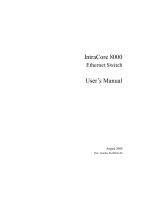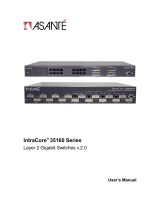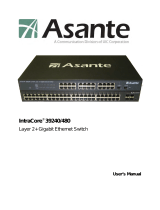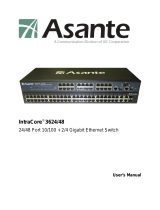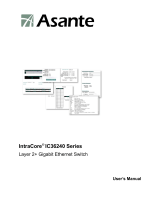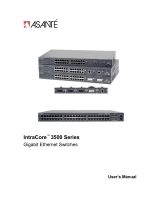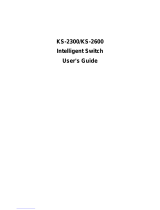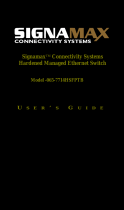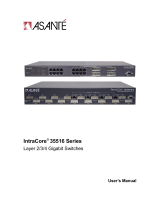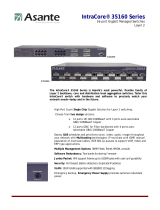Page is loading ...

IntraCore
™
65120 Series
Gigabit Ethernet Switches
User’s Manual

2
Quick Start Guide
Follow these steps to install the IntraCore 65120:
1. Open the box and check the contents. See Chapter 2.1 Package Contents for a complete list of the
items included with your IntraCore 65120.
2. Install the IntraCore 65120 switch in an equipment or wall rack, or prepare it for desktop placement.
3. Connect the power cord to the switch.
4. Connect network devices to the IntraCore 65120.
Refer to Chapters 3 and 4 to configure the IntraCore 65120 for management capabilities.
For more information on installing the IntraCore 65120, please refer to Chapter 2.2 Installation.

3
IntraCore
™
65120 Series
Gigabit Ethernet Switches
User’s Manual
Asanté Technologies, Inc.
821 Fox Lane
San Jose, CA 95131
USA
SALES
800-662-9686 Home/Office Solutions
800-303-9121 Enterprise Solutions
408-435-8388
TECHNICAL SUPPORT
801-566-8991 Worldwide
801-303-3787 FAX
www.asante.com
Copyright © 2001 Asanté Technologies, Inc. All rights reserved. No part of this document, or any associated
artwork, product design, or design concept may be copied or reproduced in whole or in part by any means
without the express written consent of Asanté Technologies, Inc. Asanté is a registered trademark and the
Asanté logo and IntraCore are trademarks of Asanté Technologies, Inc. All other brand names or product
names are trademarks or registered trademarks of their respective holders. All features and specifications
are subject to change without prior notice.
57-10027-00 Rev. A

4
Table of Contents
Quick Start Guide 2
Chapter 1 Introduction 6
1.1 Front Panel Descriptions 6
1.2 LED Definitions 7
1.3 Management 8
Chapter 2 Installation and Setup 10
2.1 Package Contents 10
2.2 Installation Overview 10
2.3 Setup 12
2.4 Password Protection 13
2.5 IP Assignment 14
2.6 SNMP Host Access 15
Chapter 3 Web-Based Management 16
3.1 Web Pages 16
3.2 Introduction 17
3.3 System Manager 17
3.4 Port Manager 20
3.5 Address Manager 20
3.6 Spanning Tree 21
3.7 VLAN Setup 22
3.8 Port Trunking 23
3.9 Port Mirroring 24
3.10 SNMP (Simple Network Management Protocol) Management 24
3.11 IGMP (Internet Group Management Protocol) Management 26
3.12 Statistics 26
Chapter 4 Console Interface 28
4.1 User Interface 28
4.2 Characteristics 28
4.3 Main Menu 28
4.4 System Manager 29
4.5 Port Manager 31
4.6 Address Manager 31
4.7 Spanning Tree 32
4.8 VLAN Setup 33
4.9 Port Trunking 33
4.10 Port Mirroring 34
4.11 Simple Network Management Protocol (SNMP) Management 34
4.12 Internet Group Management Protocol (IGMP) Management 35
4.13 Statistics 35
Chapter 5 Firmware Update Procedure 36
Chapter 6 Switching Concepts 37
6.1 Spanning Tree Protocol 37
6.2 Full Duplex, Flow Control and Auto-negotiation 38
Appendix A: Troubleshooting 40
Appendix B: VLAN Description and Examples 41
Appendix C: Features, Defaults and Specifications 44

5
Appendix D: FCC Compliance and Safety Statements 46
Appendix E: Online Warranty Registration 47

6
Chapter 1 Introduction
Thank you for purchasing the Asanté IntraCore 65120 Series Gigabit Ethernet switch. In addition to the
traditional console and telnet interface, this switch can also be configured and managed through a user-
friendly web browser interface. With an on-board HTTP server, users can access the box with the use of
popular browsers such as Netscape Navigator and Microsoft I.E (Netscape Navigator 4.0 and IE 4.01 or
higher required). The IntraCore 65120 also supports firmware updates using the TFTP protocol.
This manual is designed for System Administrators, Information Technologies Professionals, and other
users who are familiar with the setup and operation of managed networks. This chapter describes the
functional overview of the Gigabit Ethernet switch:
• Front/Rear Panel Description
• LED Definitions
• Management
1.1 Front Panel Descriptions
The front panel contains all the Ethernet ports, Console port, and LEDs. There is one System LED, four
LEDs for each copper port (model 65120-2G only), and one LED for each GBIC port. Detailed definitions
can be found Table 1-1.
Figure 1-1: 65120-2G
Figure 1-2: 65120-12G

7
1.2 LED Definitions
The following Table describes the LEDs, which allows monitoring of the status of your switch:
Port LED Color ON OFF
N/A Power/System
Green
Amber
Red
Power is up
Booting
Failure
Power is off or system is
initializing
10/100/1000 1G Link Green A valid 1000 Mbps link has
been established
No 1000 Mbps link has been
established
10/100/1000 10/100 Link Green A valid 10/100 link has been
established
No 10/100 Mbps link has been
established
10/100/1000 Activity Blinking Green Traffic detected No traffic detected
10/100/1000 FDX/HDX Solid Green
Blinking Green
Full Duplex
Collisions occurring in half-
duplex
No Full Duplex link has been
established, or no collisions are
occurring in half-duplex
GBIC Link Green A valid link has been
established
No GBIC link has been
established
Table 1-1 LEDs

8
1.3 Management
There are three different methods by which a user can manage the switch: web, console/telnet, or SNMP.
1.3.1 Web-Based Interface
Users can configure the switch, monitor the LED panel, and display statistics graphically with Netscape
Navigator browser version 4.0 or higher and Microsoft IE version 4.01 or higher. With Internet access, users
can link directly to the local switch’s home page. Detailed description is found in Chapter 3 Web-Based
Management.
1.3.2 Console Interface
Users can also access the switch in a more traditional way by connecting a PC or terminal to the console
port or by telnet across the network. The menus are organized in a manner similar to the web-based
interface. A detailed description is in Chapter 4 Console Interface.
1.3.3 SNMP Interface
Since the switch supports SNMP, users can manage the switch with an SNMP-compatible management
station running platforms such as HP OpenView. It also supports a comprehensive set of MIB extensions
along with MIB II, Ethernet MIB, the 802.1d bridge MIB, and the 4 groups of RMON.
SNMP v.1 is implemented. The SNMP agent decodes the incoming SNMP messages and responds to these
requests with MIB objects that are stored in the database. For the statistics and counters of MIB Objects, the
SNMP agent periodically (every 5 seconds) updates the MIB Objects.

9
1.3.4 Management Information Bases (MIBs)
The system supports the following MIBs:
1. MIB II (RFC 1213)
2. Ethernet Interface MIB (RFC 1643)
3. Bridge MIB (RFC 1493)
4. 4 groups of RMON (RFC 1457)
• The Ethernet Statistics Group
• The Ethernet History Group
• The Alarm Group
• The Event Group
5. Enterprise MIB
• CommGroup: Allows users to configure the community database
• HostGroup: Allows users to configure the hosts
• MiscGroup: Allows users to configure miscellaneous items
• SpanGroup: Allows users to configure the Spanning Tree
• ConfigGroup: Allows users to configure the system

10
Chapter 2 Installation and Setup
This chapter provides the following information:
• Package Contents
• Installation
• Setup
• Password Protection
• IP Assignment
• SNMP Host Access
2.1 Package Contents
The IntraCore 65120 package contains the following:
• IntraCore 65120 Series Gigabit Ethernet switch
• Getting Started Guide (printed)
• Power Cord
• Self-adhesive rubber feet for desktop placement
• Rack mount kit for rack installation
• IntraCore 65120 CD-ROM with user’s manual, utilities and product information
If any of these items are missing, contact your dealer immediately.
2.2 Installation Overview
The switch may be installed into an equipment or wall rack, or it may be placed on a level and stable
desktop surface.
The following guidelines will help you prepare to install the switch in such a way that it has the proper power
supply and environment.
2.2.1 Safety Overview
The following information provides safety guidelines to ensure your safety and to protect the switch
from damage.
Note: Be aware, however, that this information is intended as a guideline, and may not include every
possible hazard to which you may be exposed. Use caution when installing this switch.
• Only trained and qualified personnel should be allowed to install or replace this equipment.
• Always use caution when lifting heavy equipment
• Keep the unit clean
• Keep tools and components off the floor and away from foot traffic
• Avoid wearing rings or chains (or other jewelry) that could get caught in the switch. Metal objects
can heat up and cause serious injury to persons and damage to the equipment. Avoid wearing
loose clothing (i.e. ties or loose sleeves)
When working with electricity, follow these guidelines:
• Before accessing the interior of the switch, locate the emergency power-off switch for the room you
are in
• Disconnect all external cables before installing or removing the cover
• Do not work alone when working with electricity
• Always check that the power has been disconnected from the circuit
• Do not tamper with the equipment

11
• Examine your work area for potential hazards (I.e. wet floors, ungrounded cables, etc.
2.2.2 Recommended Installation Tools
You will need the following tools and equipment (not included) to install the IntraCore 65120 switch:
• Number 1, number 2 and 3/16-inch flat-blade screwdrivers
• Antistatic mat or foam
2.2.3 Power Requirements
The electrical outlet should be located near the IntraCore 65120 and be easily accessible. It must also be
properly grounded.
Make sure the power source adheres to the following guidelines:
• Power: Auto Switching 110/240 VAC
• Frequency range: 50/60 Hz
• Maximum input AC Current: 1.0A at 115 VAC full load
2.2.4 Environmental Requirements
The IntraCore 65120 must be installed in a clean, dry, dust-free area with adequate air circulation to
maintain the following environmental limits:
• Operating Temperature: 0° to 40° C (32° to 104° F)
• Storage Temperature: -20° to 70° C (-4° to 158° F)
• Relative Humidity: 10% to 90% non-condensing
• Storage Relative Humidity: 10% to 95% non-condensing
Avoid direct sunlight, heat sources, or areas with high levels of electromagnetic interference.
2.2.5 Cooling and Airflow
The IntraCore 65120 uses internal fans for air-cooling. Do not restrict airflow by covering or
obstructing air vents on the sides of the switch.
2.2.6 Installation into an Equipment Rack
To install the unit in an equipment rack, use the following procedure:
Important! Before continuing, disconnect all cables from the IntraCore 65120.
1. Place the IntraCore 65120 on a flat, stable surface.
2. Locate a rack-mounting bracket (supplied) and
place it over the mounting holes on one side of the
unit.
3. Use the screws (supplied) to secure the bracket
(with a Phillips screwdriver).
4. Repeat the two previous steps on the other side of
the unit.
5. Place the switch in the equipment rack.
6. Secure the switch by securing its mounting
brackets onto the equipment rack.
Important! Make sure the unit is supported until all the mounting screws for each bracket are secured to the
equipment rack. Failure to do so could cause the unit to fall, which may result in personal injury or damage
to the unit.

12
2.2.7 Equipment Rack Guidelines
• Size: 17.25 x 10.0 x 1.7 inches
423 x 245 x 43 mm
• Ventilation: Ensure that the rack is installed in a room where the temperature remains below 40° C
(104° F). Be sure that there are no obstructions, such as other equipment or cables, blocking
airflow to or from the IntraCore 65120 vents.
• Clearance: In addition to providing clearance for ventilation, ensure that there is adequate
clearance for servicing the IntraCore 65120 from the front.
2.3 Setup
The following sections describe the various methods for setting up and managing the switch.
2.3.1 Connecting to a Console or Workstation
When attaching a workstation to the device, a standard straight-through CAT5 cable may be used, even
when the workstation is attached via a patch panel. However, when attaching to another switch or attaching
workstations via hubs, a crossover cable will need to be used. It is recommended that the switch be kept off
the network until proper IP settings have been set.
To connect the switch to a console or computer, setup the system in the following manner:
1. Plug power cord into the back of unit.
2. Attach a straight through serial cable between the RS232 port and a COM port on the PC.
3. Setup a Hyperterminal (or equivalent terminal program) in the following manner:
• Choose the appropriate COM port (COM1, COM2, etc)
• Set the data rate to 9600 Baud
• Set data format 8 data bits, 1 stop bit and no parity
• Set flow control to NONE
• In setting under Properties, choose VT100 for Emulation mode
• Select Terminal keys for Function, Arrow and Ctrl keys. Be sure the setting is for Terminal
keys, NOT Windows keys
Now that terminal is setup correctly, power on the switch (boot sequence will display in terminal).
2.3.2 Connecting Via the Web Browser Interface
To connect to the switch via your web browser, you must first have configured your computer’s IP address to
be on the same IP address subnet as the switch (192.168.0.x). For more information on how to configure
your TCP/IP settings, please refer to your computer manufacturer’s user’s manual.
You may now launch your web browser and enter the switch’s default IP address into the address field. The
Introduction page will appear, and you may proceed through the pages to configure each variable. Password
Protection is disabled by default. If this feature is enabled (via console or telnet) without having set your own
password, the default password is Asante. Asante is case sensitive and must appear exactly as it is shown
here. See Chapter 3 Web-Based Management for more information on configuring the switch via your web
browser.
2.3.3 Connecting Via Telnet
To connect to the switch via a telnet session, you must first have configured your computer’s IP address to
be on the same IP address subnet as the switch (192.168.0.X). For more information on how to configure
your TCP/IP settings, please refer to your computer manufacturer’s user’s manual.
You may now run a telnet session to configure and manage your switch. The Main Menu will appear (unless
you have enabled the Password Protection feature), allowing you to select the variables that you wish to
configure. See Chapter 4 Console Interface for more information on configuring the switch via telnet.

13
2.4 Password Protection
The Password Protection feature is disabled by default, allowing immediate access to ANYONE on the
network. To protect your switch from unauthorized changes to the configuration, you must enable the
protection feature. It can only be enabled through the console interface.
To set a password via telnet, follow these steps:
Note: Use the arrow keys to move within a menu. Press Enter to proceed, and press the Esc. Key to return
to the previous screen. Use the spacebar to toggle between highlighted choices. Please refer to Chapter 4.2
for more detailed description of the common keystrokes used within the menus.
1. From the Main menu, use the arrow keys to select a. System Manager and press Enter.
2. Select c. Security Administration.
3. Use the arrow keys to highlight a field. Press the spacebar to enable Password Protection.

14
4. Now enter your password, pressing Enter when done.
5. Enter the password again to confirm, pressing Enter when done.
6. Press Ctrl+W to save.
2.5 IP Assignment
To assign an IP address (other than the default IP address):
1. From the Main Menu, select a. System Manager.
2. Select b. IP address.
3. In the first field enter the proper IP address for this system (consult your network administrator).
4. Enter the address of the default gateway for the network to which the switch is attached.
5. Finally enter the appropriate network mask for this network (again consult your network
administrator).

15
6. Press Ctrl-W when done to save these changes.
7. After making IP changes, the system needs to be reset. Press the Esc key to return to the System
Manager Menu.
8. Go to System Manager/Reset. Use the arrow keys to select Yes to proceed with Reset.
2.6 SNMP Host Access
When the reset is complete the box should be seen on the network. If not, check the IP information again
with your network administrator to ensure that all the data is correct. By default, any PC on the network can
manage the switch via the Web Interface. However, if this is not desired, you may enable Host
Authorization, allowing only hosts that are listed in the SNMP Host Table to access the box.
Follow these steps to configure Host Access:
1. Choose a. System Manager from the Main Menu.
2. Next choose h. SNMP Management.
3. Select Host Table by using the arrow keys and pressing Enter.
4. Enter the host name and IP address. Repeat this for as many hosts as necessary. Enter Web
Interface for the community string. Press the spacebar when Disabled is highlighted. The status will
change to Active.
5. When done entering hosts, press Ctrl+W to save this data.
For other management tasks, please refer to Chapters 3 and 4. To review switching concepts, please refer
to Chapter 6.

16
Chapter 3 Web-Based Management
Web-Based Management allows switch configuration changes to be made using an Internet Web browser.
This interface also allows for system monitoring of the Switch.
Buttons featured are:
• Reload: Pulls that screen’s data from current
values on the system
• Apply: Submits change request to system and
refreshes screen data
Please refer to Chapter 6 Switching Concepts to review any features that are not familiar to you.
3.1 Web Pages
Connect to the switch through your web browser (i.e. Netscape Navigator) by using the default IP address
192.168.0.1. A login screen will appear prompting for an administrator password (only if the password is
enabled). The User Name will always be root. Enter the password to access the switch’s management
mode. Once the password is entered correctly, the front page will appear.
Note: Password protection is optional and can only be enabled through the console interface. If the
password protection is enabled without having set your own password, the default password is Asante.
Asante is case sensitive and should be entered exactly as shown.
There are eleven menu options available:
• Introduction
• System Manager
• Port Manager
• Address Manager
• Spanning Tree
• VLAN Setup
• Port Trunking
• Port Mirroring
• SNMP Management
• IGMP Management
• Statistics

17
3.2 Introduction
This page briefly describes the web-based management features, device management and Interface
operation. It contains a product overview and product features.
3.3 System Manager
The system manager contains all system operations and general information. It is organized with several
sub-folders:
• General Info: General system information and administration
• IP Settings: IP parameters
• NVRAM Admin: Save configuration or reset to factory defaults
• Firmware Update: TFTP the latest firmware for update
• Reset: Reset the switch
3.3.1 General Info
The following fields are accessible under the general info page:
• System Description
• System Name
• System Contact
• System Location
• MAC Address
The Media Access Control (MAC) address and the System Description are not configurable.

18
3.3.2 IP Settings
There are three tunable parameters to be set by the system administrator:
• Enter site-specific IP address, Gateway address and Network mask
• Click Apply to change the IP settings
• Save Configuration to NVRAM and reset the system to implement the changes
3.3.3 NVRAM Admin
After making any changes to the screens within the Web Interface, users must save the changed settings to
Non-Volatile Random Access Memory (NVRAM). This is done in the system administration screen in order
for the new settings to remain after a system reboot.
Save Configuration to NVRAM
• Click on the Save button to save configuration to NVRAM
Restore Defaults
• Click on Restore Defaults to reset the switch’s parameters to their original default settings. In
order for changes to occur, you must reset the switch.
Note: Network IP settings (i.e. IP address, Gateway Address, Network Mask) will not be affected by
this command.
Restore Defaults without Boot Parameters
• Click on Restore Defaults without Boot Parameters to reset MOST of the switch’s parameters,
but leaves the IP address information and the boot loader configuration alone, so that the switch is
still up and manageable.

19
3.3.4 Firmware Update
On the Firmware Update screen, the system can be configured to download and boot from a new image off
the network (Please refer to Chapter 5 when updating software). Choose from the following options:
Net option:
This option allows the user to try out a new image before upgrading. It requires a TFTP server and a server
IP address to retrieve the specified image from the given IP address. The new image will not overwrite the
one in the flash (This option is the default setting.).
Net & save option:
This option requires the same setup as the Net option, i.e. TFTP server and a new image. However, it
copies the image to the flash directly and the system boots from the flash afterwards.
Last Saved option:
This option will automatically show up after the Net & save option is selected and the unit is reset. Save the
configuration to NVRAM and reset the switch. The image will load automatically after the switch resets.
Enter the TFTP Server IP Address and Filename information in the appropriate fields.
3.3.5 Reset
In this screen the user can reset the switch. This is primarily used to update the firmware or restore defaults.

20
3.4 Port Manager
This page will allow access to the port parameters. The configurable parameters are available as follows:
• Port Name
• Port Enable
• Auto Negotiation
• Operating Parameters
• Flow Control
• HOL Blocking
3.5 Address Manager
The Address Manager allows you to add or remove static address entries as well as change the dynamic
address aging times.
3.5.1 Static Addresses
Any system whose MAC address and the port number are listed in this screen will not be purged from the
system’s forwarding table by the Aging process.
Add a new entry:
• Enter the MAC address and port in the appropriate boxes (You must enter the MAC address in the
form XX:XX:XX:XX:XX:XX)
• Click Add
/
